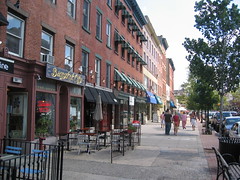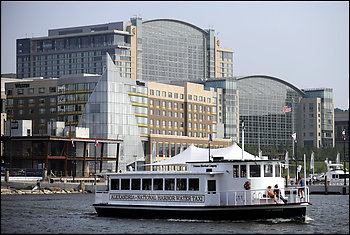Peopling Places in Chicago (and elsewhere)

Washington Avenue, Hoboken, New Jersey. Photo by Steve Pinkus.
is a new blog (which I found because from time to time I check out the blogs that link to mine) focusing on the Logan Square area of Chicago.
It's a particularly interesting read for me because the author has read some of the same books as I (I bought City: Rediscovering the Center from Common Concerns in the early 1990s, although I wasn't involved in local revitalization activities then, I was just interested in urban issues) and it seems as if Logan Square has many of the same issues and conditions as does H Street NE, where I got particularly involved starting in 2000.
I lived within one block of the main drag, H Street, just as the blogmaster of Peopling Places lives within one block of Milwaukee Avenue. For me, many of his entries appear to parallel the kind of learning and experiences I went through on H Street. It's almost eerie.
Anwar Saleem, now the director of H Street Main Street, but originally the board chair and like me, one of the founders of that group, and I talk all the time about "what we know now" vs. the "what we knew then" back in 2001 when a group of us started to bring resident energies into the revitalization equation, first working with the merchants association, and later creating a Main Street organization, after the city under Mayor Williams, launched a city-wide Main Street program.
Sadly, for many reasons the Main Street program isn't working out so well in DC. It's impolitic for me to discuss why in great detail.
It's partly the organizations and the level of community capacity. It's partly how the city government deals with the programs and how long it takes to release funding as well as funding recissions. It's also because I don't think people really understand how difficult it is to reseed retail generally--as an industry traditional retail is amongst the most concentrated of U.S. industries--especially when you want it to be independently owned and operated so that it is distinct and contributes to the unique identity of neighborhoods, commercial districts, and center cities.
-- (Yesterday's) Testimony on the DC Main Streets program (2007)
-- I hope New Orleans('s urban Main Street program) can learn from DC (2006)
-- Yesterday's testimony on the DC Main Streets program (2005)
--Main Street and getting schooled in politics, constituency building, and building support for your program (2006)
In fairness to all the stakeholders, it's also hard. These neighborhoods have experienced as much as 60 years of disinvestment, some of the commercial districts are scarred by riots, and it was unreasonable to expect--after many years if not decades of failed government initiated attempts to induce improvement--that volunteers with a wee bit of money and government support could turn things around in a couple years. (Of course, that was the expectation of many.)
And at the same time, local commercial districts and retailers compete within a vibrant and hyper-competitive regional retail landscape.
-- (Why aren't people) Learning from Jane Jacobs revisited (2006, 2005)
-- Signs, signs, and the necessity of design review (2005)
-- Forcing Retail Displacement by the disconnection of tax assessment models from public policy goals (2005)
-- Why the future of urban retail isn't chains (2005)
E.g., in the DC region, DC has just gotten clomped by the opening of National Harbor in nearby Prince George's County, which creates major competition for conferences and small and mid-sized meetings, especially because the conference center operator, Gaylord, has other facilities (such as the Grand Old Opry in Nashville) so they are able to leverage their relationships developed elsewhere to steer new and more business to their facilities instead of it going to DC.
See "National Harbor's 'Mini-City' Takes Shape," from the Washington Post. Both Gaylord, and the master developer, Peterson Companies, are hardcore competitors. National Harbor is being programmed every weekend with special events, farmers markets, etc. (Peterson Companies is the master developer for Silver Spring, and they also own some shopping centers in the region.)
As I say to retailers and restauranteurs, "to stay the same is to fall behind, because your best competitors are always working to improve. And your customers are also their customers. Your customers are constantly learning about what is quality retail and what isn't and they will shop where their needs are best met."
And DC just isn't quite big enough for local retail to stay local. Even Hecht's, one of the more successful department store chains in the U.S. (it was owned by May), which grew from a store in Washington and in Baltimore (where it started) to a 70+ store chain from Pennsylvania to North Carolina (mostly through acquisition), has been rolled up into Macy's. So the local support network and infrastructure to support local retailers isn't very strong.
But I didn't know any of this in 2000, when I started getting involved in the revitalization of H Street NE. Now I tend to focus on issues with more "city-wide" import, and I do some consulting, some local, as well as in locales outside of the region.
-------
Other good resources include reports from the Urban Land Institute:
- Ten Steps for Developing Successful Town Centers
- Ten Steps for Rebuilding Neighborhood Retail
- Ten Steps for Rethinking the Mall (and their reports on suburban business district improvement are worth reading too as revitalization is more about what to do rather than the specific place albeit categorized, Reinventing Suburban Business Districts and Reinventing America's Suburban Strips);

National Harbor, Prince George's County. Photo: John Mcdonnell -- The Washington Post.
Labels: commercial district revitalization, urban-design-placemaking



0 Comments:
Post a Comment
<< Home